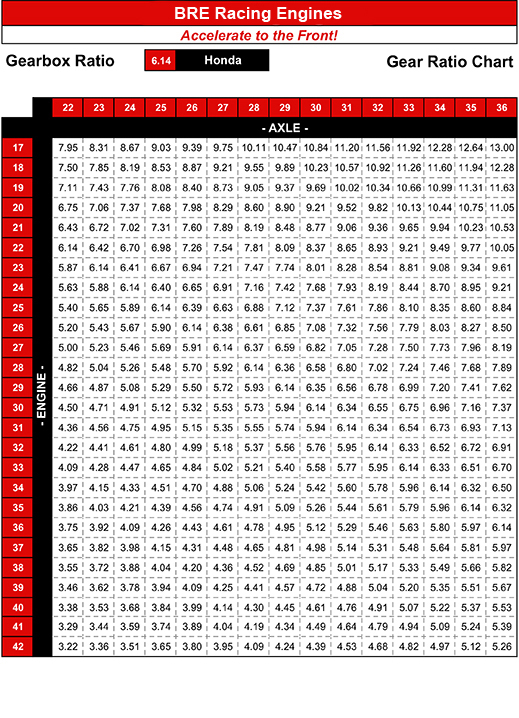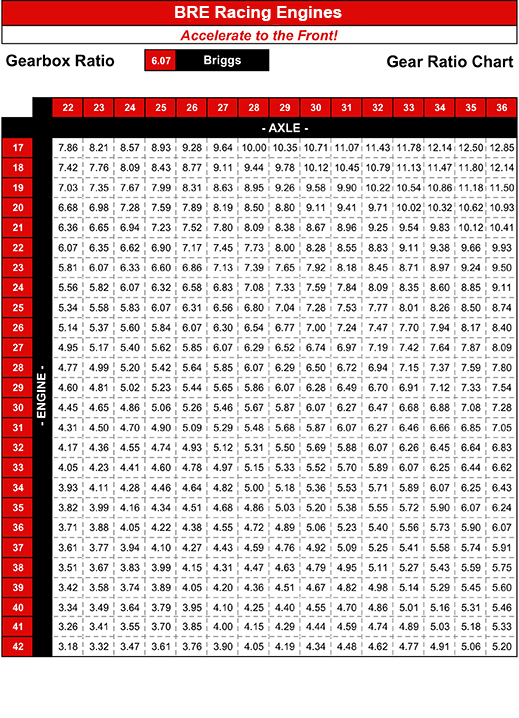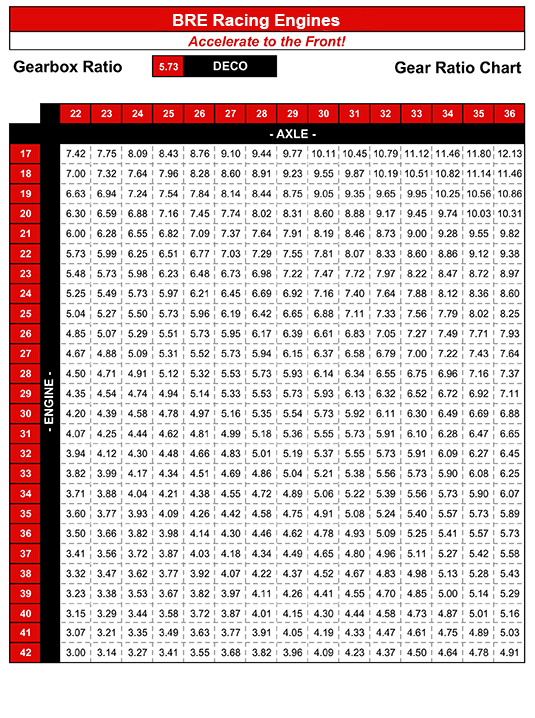
BRE Racing Engine
Tech Center
BRE QM Gear Charts
Long term storage of race engines.
As the racing season is coming to an end for many racers keep in mind that proper long term storage of your race engines is very important. If the engine is going to be stored for many months the following procedures are important to protect your engine from corrosion and damage.
1) Drain all fuel from fuel tank, fuel lines and carburetor bowl.
2) Remove spark plug and pour about a teaspoon of oil into spark plug hole.
3) Reinstall the spark plug and rotate engine a few revolutions to distribute oil onto cylinder wall.
4) Hand rotate engine until piston is located at exactly top dead center on the compression stroke. ( very important! )
5) If the header and air filter are removed cover these holes with tape or a cap.
6) This is very important, store engine in a dry warm location.
Engine Storage Reminder
Remember to park the piston at top dead center on the compression stroke during engine storage even racing weekly or longer between races. The cylinder wall can still generate rust on it when either the intake of exhaust valve is open. This is very important when storing race car in a trailer during cold or humid weather conditions.
|
|
Animal Engine Quarter Midget hard starting fix Over the past few months coordinated testing has taken place with the support Briggs & Stratton engineers to analyze and develop a solution to the hard starting of the Animal engine during handler push starts. The fundamental problem is caused from high cylinder combustion pressures at a low RPM during push starts. After evaluations of F/A ratio modifications, various ignition timing levels and camshaft compression release RPM levels it has been determined the simplest solution is to perform a 10 minute modification to the camshaft compression release centrifugal force levers. This will allow the engine to start during pushing the car to start and accelerate to approx 1500 RPM before the camshaft compression release is disengaged. This modification to the camshaft is in no way any performance enhancement while engine is being raced. If you would like more detail on this topic feel free to call us. |
Animal Engine Quarter Midget carb tech update Over the past few months we have been evaluating and testing the Animal engine for Quarter Midget racing. One of the problems that has plagued this form of racing is an engine sputter or missing when the car is in the corners. This problem is due to a fuel rich carb condition. The solution that we have found is to reduce the fuel delivery. The best way for this is to adjust the float height to .900 inches and a float drop of 1.050 inches. You may also have to make an adjustment to the size of the main jet to for a leaner condition. To make the float height adjustment the carb will have to be removed and held in a inverted position. If you have questions about this please give us a call. |
|
|
Fuel delivery to the Animal & World Formula carb BRE recommends that you always use a pulse type fuel pump. This will insure that the float bowl will always have consistent fuel level. We have seen some racers in the quarter midgets run the fuel line from the fuel tank directly into the carb inlet. This method will allow the carb to run lean or possibly out of fuel at high engine speeds and especially when the fuel tank level becomes low. Always running a fuel pump will assure a constant air fuel ratio for maximum performance. |
Animal valve spring failures I want to caution all the racers about Animal valve spring failures caused from surface corrosion fatigue. We have experienced 2 engines so far this year that have fractured valve springs. Our determination of the cause was surface corrosion. In both of these cases the racers had raced in the rain and not drained the oil after the race and had let this dirty high moisture content oil sit in the motor for a few days. This will cause the internal metalic engine parts to rust. I want to caution everyone that races in the rain to immediately after the race run engine on gas and drain the old oil out of engine. And to be real sure run the engine again on clean oil and drain again. |
Motor oil cleanliness I want to remind everyone reading this tech update how important it is to keep clean oil in your motors. Make sure that your funnel is clean and when you remove the filler cap that no dirt drops into motor. Contamination and wear debris in motors causes the internal engine components to become scored. This in turn will cause the overall friction to increase and a HP loss. Keep your engine oil clean and change frequently, like every other session on race track on pavement racing or every session on dirt racing. |
|
|
Rain racing with Animal motor I am seeing a few motors back for rebuilds that have excessive wear on the rings and cylinder wall after rain racing. Because of the Animal carb location directly over the right rear tire this makes it more difficult to keep water out of the carb. Please make sure you have a proper designed air filter cover when rain racing. |
Oil additives I would like to caution everyone that some of the oil additives that are on the market cause problems after their use in Animal motors. After you use them for a few weeks the oil leaves a think pasty residue on the internal crankcase components. After time this builds up to the point that the friction increases and will cause reduced HP. Please consult with your engine builder before adding an oil additive. I personally am not in favor of using any oil additiv |
Animal Walbro carb maintenance The proper method to flush out the Alky from your Animal Walbro carb at the end of your race day is as follows. First disconnect the inlet fuel line from the fuel pump, then open the drain screw on the bottom of the carb bowl. Now blow air through the fuel pump inlet, this will flush out all the Alky from the fuel pump and carb. Next close the carb bowl drain screw and connect a hose from pump gasolne and turn engine over with electric starter until engine starts, run for 5 to 8 seconds. Then open the carb drain screw and again blow into the fuel pump inlet port, this will flush out the gasoline from the fuel pump and carb. Now tighten the carb bowl drain screw. This method will assure that your carb will not become corroded from the Alky. |
BRE Racing Engines QM Tech Guide |



